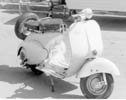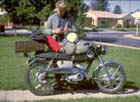| | ||||||||||||||||||||
 | ||||||||||||||||||||
| My involvement with two wheelers began in the 50s when motorcycling in America was very different than today. Few of us rode two wheelers, but if we did, they were more likely to be scooters like Cushmans, Vespas, or Lambrettas. | ||||||||||||||||||||
| My Vespa, 1958 | ||||||||||||||||||||
 | ||||||||||||||||||||
| The most popular motorcycles were imports like Triumph and BSA. Harley - Davidsons were thought to be for old guys. All bikes of the time were loud and dirty because of oil leaks. All had to be kick started. | ||||||||||||||||||||
| BSA of the era | ||||||||||||||||||||
| In 1962, everything changed. One morning I watched a fellow student at the University of Illinois ride up on a very different kind of motorcycle. It sparkled in the sun, was absolutely quiet, didn't smoke, and didn't drip oil. And, when that student left, he rolled it off the center stand and quietly continued on his way. He had an electric starter! His bike turned out to be a Honda 50 Cub. And with it, Mr. Honda got the Baby Boom Generation interested in two wheelers - a habit that keeps them on Harley - Davidsons today. | ||||||||||||||||||||
 | ||||||||||||||||||||
| Honda 50 of 1962 | ||||||||||||||||||||
| Beginning with 50 cc sized engines, Honda, joined by Yamaha and Suzuki soon upped the ante to 90cc. We who were hooked couldn't wait to get rid of our old machines and buy the next size up. By 1965, 160s and 250-305s were the current "big" bikes. | ||||||||||||||||||||
| After graduating from the University of Illinois, I watched my friend, Duane Anderson, ride his Honda 250 to the Aspen Design Conference. Hardly anybody actually rode cross-country on Japanese bikes. I didn't know you could do that. So the next year, I rode my Yamaha 305 to Aspen, too. This was an unusual thing to do. Most people thought they were too little to be real motorcycles. No industry had yet emerged to cater to them. The only accessories available were luggage racks. Cycle World Magazine was barely two years old. Joe Parkhurst, its publisher, understood what was happening. His "Report from Japan" was why we read CW. I had no idea that I would get to meet him within the year. | ||||||||||||||||||||
 | ||||||||||||||||||||
| Craig touring 1966 style. Hardly anybody made accessories for Japanese bikes. | ||||||||||||||||||||
| Somewhere in Kansas a big truck passed me, breaking the wind from in front of me allowing me to sit up and open my eyes. I had been driving hunched over all day, squinting to see the road ahead. This was no way to ride. I realized that I wanted some kind of wind protection. In October of 1966, I began designing a fairing to make my Japanese bike suitable for our American touring style. From that point on, motorcycles would dominate my life. | ||||||||||||||||||||
| Fairings were around long before Vetter: | ||||||||||||||||||||
| I did not invent the motorcycle fairing. Three brands were known to us in the 60s. The English "Avon" and "Butler" brands were "dolphin-style", frame-mounted fairings. They were neat looking but not suitable to the American riding style of sitting upright with high, wide handlebars. The American brand best known was Wixom made by Dean and Stan Wixom. Wixom fairings were handlebar-mounted and were made for the American riding stance and were popular on BMWs. The current Harley "Batwing" fairing is a derivative. My first fairing, the Series 1000 was like an English fairing made wider for American handlebars. My design was also much simpler. Mine was the first fairing that was not "more trouble than it was worth". In addition, I was able to figure out how to make and market it. |  | |||||||||||||||||||
| Other fairings of the period | ||||||||||||||||||||
 | ||||||||||||||||||||
| End as of Nov 19, 2002 | ||||||||||||||||||||








